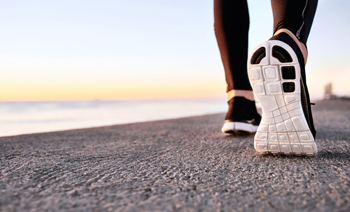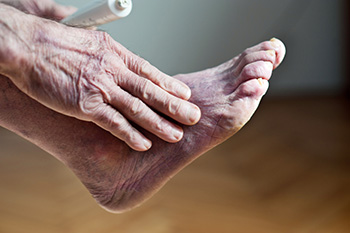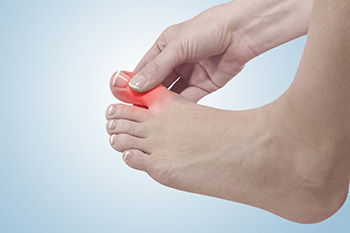Items filtered by date: May 2022
Being Properly Fitted for Walking Shoes

When it comes to finding the right walking shoe, you want to start by being properly fitted. Stores that specialize in athletic shoes will most likely have professional staff on hand to properly measure your feet and work with you as you are trying shoes on to ensure a proper fit. Make sure you try shoes on wearing the same socks that you will wear once you start using the shoes. Make sure the shoes feel great in the store, and do not assume that they will feel better once you “break them in” at home. Do not buy any shoe that has areas that rub against your feet. A podiatrist can also measure your feet and offer professional advice on the type of running shoe that is most appropriate for your particular feet. They can also create custom orthotics to address any gait abnormalities or structural issues your feet may have.
Getting the right shoe size is an important part of proper foot health. Seek the assistance of Edward S. Pozarny DPM from Arlington Podiatry Center. Our doctor will provide the care you need to keep you pain-free and on your feet.
Getting the Right Shoe Size
There are many people who wear shoes that are the incorrect size, negatively affecting their feet and posture. Selecting the right shoes is not a difficult process, so long as you keep several things in mind when it comes to choosing the right pair.
- When visiting the shoe store, use the tools available to measure your foot.
- Be sure there is ‘wiggle room’. There should be about an inch between your toes and the tip of your shoes.
- Do not always assume you are the same size, as manufacturers run differently.
- Purchase shoes later in the day, as your feet swell as the day progresses.
- If a shoe is not comfortable, it is not suitable. Most shoes can’t be ‘broken in’, and comfort should be the ultimate goal when it comes to choosing the right pair of shoes
As our feet hold our body weight and keep us moving, it is important to treat them right. Picking the right pair of shoes can provide your feet comfort and mobility without pain.
If you have any questions, please feel free to contact our office located in Arlington, VA . We offer the newest diagnostic and treatment technologies for all your foot care needs.
Surgery for Ankle Arthritis

People who have severe arthritis may consider having a surgery performed that is known as a triple arthrodesis. It is a procedure that fuses three joints of the ankle. It may help to have this type of foot surgery done to relieve pain if the joints are deformed or unstable as a result of arthritis. Existing conditions that may qualify for a triple arthrodesis can include ankle instability, severe flat foot, or extremely high arches. Some patients have abnormal connections between the bones and may consider this type of surgery. A proper diagnosis is performed by having X-rays taken, which can be beneficial to completely understanding the problems in the ankle. There may be risk factors with this type of surgery. Bones may fuse abnormally, and there could be delayed wound healing or nerve injury. If you have arthritis, and it is severely affecting your ankle, it is suggested to consult with a podiatrist who can determine if this surgery is correct for you
Foot surgery is sometimes necessary to treat a foot ailment. To learn more, contact Edward S. Pozarny DPM of Arlington Podiatry Center. Our doctor will assist you with all of your foot and ankle needs.
When Is Surgery Necessary?
Foot and ankle surgery is generally reserved for cases in which less invasive, conservative procedures have failed to alleviate the problem. Some of the cases in which surgery may be necessary include:
- Removing foot deformities like bunions and bone spurs
- Severe arthritis that has caused bone issues
- Cosmetic reconstruction
What Types of Surgery Are There?
The type of surgery you receive will depend on the nature of the problem you have. Some of the possible surgeries include:
- Bunionectomy for painful bunions
- Surgical fusion for realignment of bones
- Neuropathy decompression surgery to treat nerve damage
Benefits of Surgery
Although surgery is usually a last resort, it can provide more complete pain relief compared to non-surgical methods and may allow you to finally resume full activity.
Surgical techniques have also become increasingly sophisticated. Techniques like endoscopic surgery allow for smaller incisions and faster recovery times.
If you have any questions please feel free to contact our office located in Arlington, VA . We offer the newest diagnostic and treatment technologies for all your foot and ankle needs.
Children, Physical Activity, and Sever’s Disease

The heel condition that is referred to as Sever’s disease generally affects children and young teenagers who are involved in sporting activities. The heel can often feel sore when Sever’s disease is present, and it may be difficult to walk. It is defined as a condition that affects the growth plate in the heel, and can be confirmed by having a physical examination performed. Relief is often found when the activity that caused the condition is stopped, and the heel is frequently rested. It is important to practice specific stretches once the heel feels better, and this may help to accelerate the recovery process. Many patients choose to wear a heel cushion in their shoe which may be able to provide additional padding. If your child is affected by Sever’s disease, it is advised that a podiatrist be consulted for proper prevention and healing tips.
Sever's disease often occurs in children and teens. If your child is experiencing foot or ankle pain, see Edward S. Pozarny DPM from Arlington Podiatry Center. Our doctor can treat your child’s foot and ankle needs.
Sever’s Disease
Sever’s disease is also known as calcaneal apophysitis, which is a medical condition that causes heel pain I none or both feet. The disease is known to affect children between the ages of 8 and 14.
Sever’s disease occurs when part of the child’s heel known as the growth plate (calcaneal epiphysis) is attached to the Achilles tendon. This area can suffer injury when the muscles and tendons of the growing foot do not keep pace with bone growth. Therefore, the constant pain which one experiences at the back of the heel will make the child unable to put any weight on the heel. The child is then forced to walk on their toes.
Symptoms
Acute pain – Pain associated with Sever’s disease is usually felt in the heel when the child engages in physical activity such as walking, jumping and or running.
Highly active – Children who are very active are among the most susceptible in experiencing Sever’s disease, because of the stress and tension placed on their feet.
If you have any questions, please feel free to contact our office located in Arlington, VA . We offer the newest diagnostic and treatment technologies for all your foot and ankle injuries.
Treat Your Feet to Diabetic Shoes
Foods and Exercises May Help Poor Circulation

It is common for diabetic patients to have poor circulation in their feet. This is often the result of elevated blood sugar levels. Neuropathy can accompany this. It can be difficult to feel cuts and wounds on the feet, and the blood vessels can diminish in size. There are several methods to help poor circulation in the feet. These can consist of getting regular foot examinations, monitoring glucose levels, and wearing diabetic socks. Research has indicated that performing specific exercises may improve circulation in the feet. Some exercises can include cardiovascular activity such as walking or biking for five days per week. Additionally, it is important to keep blood pressure at a normal level and refrain from walking barefoot. Foods that are rich in vitamin C may help to naturally thin the blood, and it may help to incorporate foods that are rich in fiber into your daily food plan. If your feet are affected by poor circulation, it is strongly suggested that you confer with a podiatrist who can help you to manage this condition.
Poor circulation is a serious condition and needs immediate medical attention. If you have any concerns with poor circulation in your feet contact Edward S. Pozarny DPM of Arlington Podiatry Center. Our doctor will treat your foot and ankle needs.
Poor Circulation in the Feet
Poor blood circulation in the feet and legs is can be caused by peripheral artery disease (PAD), which is the result of a buildup of plaque in the arteries.
Plaque buildup or atherosclerosis results from excess calcium and cholesterol in the bloodstream. This can restrict the amount of blood which can flow through the arteries. Poor blood circulation in the feet and legs are sometimes caused by inflammation in the blood vessels, known as vasculitis.
Causes
Lack of oxygen and oxygen from poor blood circulation restricts muscle growth and development. It can also cause:
- Muscle pain, stiffness, or weakness
- Numbness or cramping in the legs
- Skin discoloration
- Slower nail & hair growth
- Erectile dysfunction
Those who have diabetes or smoke are at greatest risk for poor circulation, as are those who are over 50. If you have poor circulation in the feet and legs it may be caused by PAD and is important to make changes to your lifestyle in order to reduce risk of getting a heart attack or stroke. Exercise and maintaining a healthy lifestyle will dramatically improve conditions.
As always, see a podiatrist as he or she will assist in finding a regimen that suits you. A podiatrist can also prescribe you any needed medication.
If you have any questions please feel free to contact our office located in Arlington, VA . We offer the newest diagnostic and treatment technologies for all your foot and ankle needs.
Osteoarthritis May Be Damaging Your Big Toe Joint

The cartilage in a joint can become damaged and worn down from the condition known as osteoarthritis (OA). This can expose bones in the damaged joint and cause them to rub together. OA often attacks the first metatarsophalangeal joint (at the base of the big toe). A variety of symptoms may occur including pain, swelling, and limited mobility. The body may respond by creating more bone which can develop into bone spurs that cause visible bumps, calluses, or a bunion in the big toe. In time, the pain can become more of a burning sensation and stiffness may set in to the point where the big toe becomes fixed (hallux rigidus) and unbendable. Age can be a contributing factor to OA, as well as prior injuries, obesity, and a genetic predisposition to the disease. Losing weight, taking anti-inflammatories, and icing the area may provide some relief from OA in the big toe. A podiatrist can provide orthotics, braces or splints, recommend proper shoes, suggest specific exercises and even use injectable corticosteroids to relieve pain and reduce swelling. In some cases, surgery may be necessary to remove deteriorated cartilage or repair/replace a severely damaged joint. Contact a podiatrist if you believe OA is causing pain and swelling in your big toe joint.
Arthritis can be a difficult condition to live with. If you are seeking treatment, contact Edward S. Pozarny DPM from Arlington Podiatry Center. Our doctor can provide the care you need to keep you pain-free and on your feet.
Arthritic Foot Care
Arthritis is a joint disorder that involves the inflammation of different joints in your body, such as those in your feet. Arthritis is often caused by a degenerative joint disease and causes mild to severe pain in all affected areas. In addition to this, swelling and stiffness in the affected joints can also be a common symptom of arthritis.
In many cases, wearing ill-fitting shoes can worsen the effects and pain of arthritis. Wearing shoes that have a lower heel and extra room can help your feet feel more comfortable. In cases of rheumatoid arthritis, the arch in your foot may become problematic. Buying shoes with proper arch support that contour to your feet can help immensely.
Alleviating Arthritic Pain
- Exercises that stretch the foot can prevent further pain and injury and increase mobility
- Most of the pain can be alleviated with anti-inflammatory drugs, heat, and topical medications
- Massages can help temporarily alleviate pain.
It is best to see your doctor for the treatment that is right for your needs and symptoms. Conditions vary, and a podiatrist can help you determine the right method of care for your feet.
If you have any questions, please feel free to contact our office located in Arlington, VA . We offer the newest diagnostic tools and technology to treat your foot and ankle needs.

